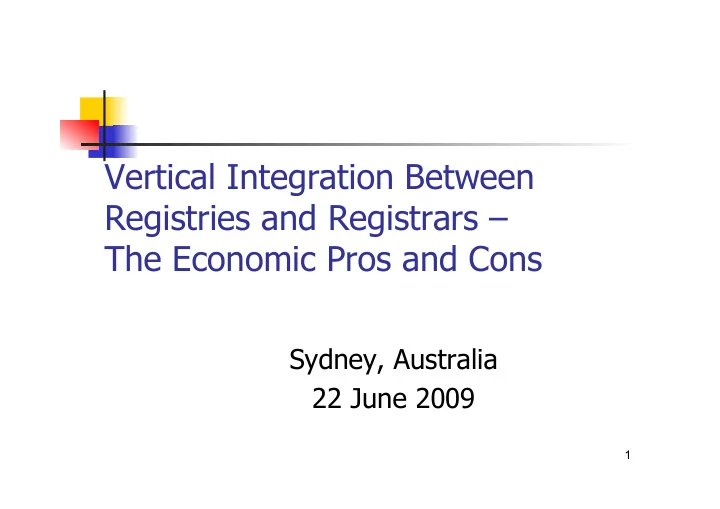

Vertical Integration Between Registries and Registrars – The Economic Pros and Cons Sydney, Australia 22 June 2009 1
Background Issue debated since creation of ICANN Originally generated because only one (commonly owned) commercial registry operator and registrar Significant increase in competitive alternatives at registry and (especially) registrar level has not eliminated debates New gTLD plans have brought issue to forefront again 2
Discussion Panel Joe Sims – Moderator Senior Antitrust Partner, Jones Day Counsel to Jon Postel in creation of ICANN, and outside counsel to ICANN since its creation Participants Steve Salop Joshua Wright 3
Steve Salop Professor of Law and Economics, Georgetown University Law Center Formerly Associate Director for Special Projects and Industry Analysis, Bureau of Economics, US Federal Trade Commission Formerly Economist at Civil Aeronautics Board/Federal Reserve Board Prolific author and speaker; relevant publications include: Krattenmaker and Salop, Antitrust Analysis of Anticompetitive Exclusion: Raising Rivals’ Costs to Gain Power Over Price, 96 YALE LAW JOURNAL 209 (1986) Riordan and Salop, Evaluating Vertical Mergers: A Post-Chicago Approach, 63 ANTITRUST L.J. 513 (1995) Salop and Romaine, Preserving Monopoly: Economist Analysis, Legal Standards, and Microsoft, 7 GEO. MASON L. REV. 617 (1999) 4
Josh Wright Professor, George Mason University Department of Economics Assistant Professor of Law, George Mason University School of Law Formerly Scholar in Residence, Bureau of Competition, Federal Trade Commission Author of several relevant publications on the economics of vertical contractual arrangements: Antitrust Analysis of Exclusive Dealing and Tying Arrangements (with A. Abbott), in THE LAW AND ECONOMICS OF ANTITRUST (Keith N. Hylton ed. 2009) The Economics of Slotting Contracts (with B. Klein), 50 JOURNAL OF LAW AND ECONOMICS 421 (2007) Slotting Contracts and Consumer Welfare, 74(2) ANTITRUST LAW JOURNAL 439 (2007) 5
Agenda Presentation of vertical integration economics and law by the panel Purpose is to lay an educational foundation for subsequent discussions at ICANN on this topic Presentation (to best of our ability) will be objective and neutral More focused on principles than ICANN specifics Application of these principles to ICANN- specific issues, with participation from registries and registrars Discussion and questions from the floor 6
Vertical Integration Basics Vertical integration can be structural, or by contract Vertical integration can be procompetitive or anticompetitive, depending on the facts Can lead to lower prices, higher quality and better service Can lead to higher prices, lower quality or less product variety, or slower innovation 7
Assessing Effects Effects not limited to cross-ownership Exclusive/preferential vertical contracts Complex task Effects depend on numerous factors Not well suited to bright lines 8
Potential Anticompetitive Effects of Vertical Integration Exclusion -- foreclosure/discrimination Evasion of price caps Exchange of sensitive competitive information 9
Potential Consumer Benefits from Vertical Integration Lower prices Facilitate new entry by Registries Induce Registrar to provide specialized services for Registry Induce Registrar to promote Registry Allow more scope for innovation in delivery of products/services 10
Conflicting Effects of Prohibition on Vertical Integration “Under-inclusive” Vertical integration can facilitate the creation, maintenance or exercise of market power Anticompetitive effects can occur, even if firms not formally integrated “Over-inclusive” Vertical integration unlikely to raise competitive concerns in competitive markets, or markets that lack entry barriers Prohibition can prevent beneficial, pro-competitive conduct, even in concentrated markets 11
Competition Policy: General Principles Good rules focus on likely effects Facts matter! Market power Intensity of competition Barriers to entry Price caps Magnitude of benefits Restrictiveness of conduct No easy answers Simplistic rules ensure mistakes! Blanket prohibitions Complete laissez-faire antitrust Case-by-case analysis most accurate, but hardest to apply To state the obvious Any rules are only effective if rigorously enforced Changes in status quo can produce long term benefits, but also short term transition costs
Recommend
More recommend